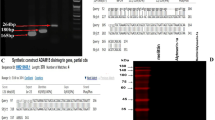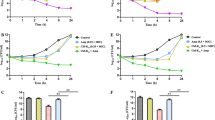Abstract
Increased prevalence of antibiotic-resistant bacteria has become a major threat to the health sector worldwide due to their virulence, limited therapeutic options and distribution in both hospital and community settings. Discovery and development of new agents to combat antibiotic-resistant bacteria is thus needed. This study therefore aimed to evaluate the ability of bovine lactoferrin (LF), peptides from two antimicrobial domains lactoferricin B (LFcin17-30) and lactoferrampin (LFampin265-284) and a chimeric construct (LFchimera) containing both peptides, as potential bactericidal agents against clinical isolates of antibiotic-resistant Staphylococcus aureus and Escherichia coli. Results in kinetics of growth show that LF chimera and peptides inhibited the growth of both bacterial species. By confocal microscopy and flow cytometry it was observed that LF and FITC-labeled peptides are able to interact with these bacteria and cause membrane permeabilization, as monitored by propidium iodide staining, these effects were decreased by preincubation with lipopolysaccharide in E. coli. By electron microscopy, a clear cellular damage was observed in bacteria after treatments with LFchimera and peptides, suggesting that interaction and membrane disruption are probably involved as a mechanism of action. In conclusion, results show that LFchimera, LF and peptides have potential as bactericidal agents in the antibiotic-resistant strains of S. aureus and E. coli and also the work strongly suggest that LFcin17-30 and LFampin265-284 acts synergistically with antibiotics against multidrug resistant EPEC and MRSA in vitro.








Similar content being viewed by others
References
Bartlett JG (2008) Methicillin-resistant Staphylococcus aureus infections. Top HIV Med 16:151–155
Bellamy W, Takase M, Wakabayashi H, Kawase K, Tomita M (1992) Antibacterial spectrum of lactoferricin B, a potent bactericidal peptide derived from the N-terminal region of bovine lactoferrin. J Appl Bacteriol 73:472–479
Bolscher JG, Adao R, Nazmi K, van den Keybus PA, van ‘t Hof W, Nieuw Amerongen AV, Bastos M, Veerman EC (2009) Bactericidal activity of LFchimera is stronger and less sensitive to ionic strength than its constituent lactoferricin and lactoferrampin peptides. Biochimie 91:123–132
CDC Center for Disease Control and Prevention (2009a). Multistate outbreak of E. coli O157:H7 infections associated with beef from jbs swift beef company http://www.cdc.gov/ecoli/2009/0701.html
CDC Center for Disease Control and Prevention (2009b) Multistate outbreak of E. coli O157:H7 infections linked to eating raw refrigerated, prepackaged cookie dough http://www.cdc.gov/ecoli/2009/0630.html
Chen HL, Yen CC, Lu CY, Yu CH, Chen CM (2006) Synthetic porcine lactoferricin with a 20-residue peptide exhibits antimicrobial activity against Escherichia coli, Staphylococcus aureus, and Candida albicans. J Agric Food Chem 54:3277–3282
Farnaud S, Evans RW (2003) Lactoferrin—a multifunctional protein with antimicrobial properties. Mol Immunol 40:395–405
Haney EF, Lau F, Vogel HJ (2007) Solution structures and model membrane interactions of lactoferrampin, an antimicrobial peptide derived from bovine lactoferrin. Biochim Biophys Acta 1768:2355–2364
Hawkey PM, Jones AM (2009) The changing epidemiology of resistance. J Antimicrob Chemother 64(Suppl 1):i3–i10
Klevens RM, Morrison MA, Nadle J, Petit S, Gershman K, Ray S, Harrison LH, Lynfield R, Dumyati G, Townes JM, Craig AS, Zell ER, Fosheim GE, McDougal LK, Carey RB, Fridkin SK (2007) Invasive methicillin-resistant Staphylococcus aureus infections in the United States. JAMA 298:1763–1771
Leon-Sicairos N, Lopez-Soto F, Reyes-Lopez M, Godinez-Vargas D, Ordaz-Pichardo C, de la Garza M (2006) Amoebicidal activity of milk, apo-lactoferrin, sIgA and lysozyme. Clin Med Res 4:106–113
Leon-Sicairos N, Canizalez-Roman A, de la Garza M, Reyes-Lopez M, Zazueta-Beltran J, Nazmi K, Gomez-Gil B, Bolscher JG (2009) Bactericidal effect of lactoferrin and lactoferrin chimera against halophilic Vibrio parahaemolyticus. Biochimie 91:133–140
Livermore DM (2009) Has the era of untreatable infections arrived? J Antimicrob Chemother 64(Suppl 1):i29–i36
Nguyen GC, Patel H, Chong RY (2009) Increased prevalence of and associated mortality with methicillin-resistant Staphylococcus aureus among hospitalized IBD patients. Am J Gastroenterol. doi:10.1038/ajg.2009.581
Orsi N (2004) The antimicrobial activity of lactoferrin: current status and perspectives. Biometals 17:189–196
van der Kraan MI, Groenink J, Nazmi K, Veerman EC, Bolscher JG, Nieuw Amerongen AV (2004) Lactoferrampin: a novel antimicrobial peptide in the N1-domain of bovine lactoferrin. Peptides 25:177–183
van der Kraan MI, Nazmi K, Teeken A, Groenink J, van ‘t Hof W, Veerman EC, Bolscher JG, Nieuw Amerongen AV (2005a) Lactoferrampin, an antimicrobial peptide of bovine lactoferrin, exerts its candidacidal activity by a cluster of positively charged residues at the C-terminus in combination with a helix-facilitating N-terminal part. Biol Chem 386:137–142
van der Kraan MI, van der Made C, Nazmi K, van ‘t Hof W, Groenink J, Veerman EC, Bolscher JG, Nieuw Amerongen AV (2005b) Effect of amino acid substitutions on the candidacidal activity of LFampin 265–284. Peptides 26:2093–2097
van der Kraan MI, van Marle J, Nazmi K, Groenink J, van ‘t Hof W, Veerman EC, Bolscher JG, Nieuw Amerongen AV (2005c) Ultrastructural effects of antimicrobial peptides from bovine lactoferrin on the membranes of Candida albicans and Escherichia coli. Peptides 26:1537–1542
van der Kraan MI, Nazmi K, van ‘t Hof W, Amerongen AV, Veerman EC, Bolscher JG (2006) Distinct bactericidal activities of bovine lactoferrin peptides LFampin 268–284 and LFampin 265–284: Asp-Leu-Ile makes a difference. Biochem Cell Biol 84:358–362
Venkitanarayanan KS, Zhao T, Doyle MP (1999) Antibacterial effect of lactoferricin B on Escherichia coli O157:H7 in ground beef. J Food Prot 62:747–750
Vidal JE, Canizalez-Roman A, Gutierrez-Jimenez J, Navarro-Garcia F (2007) Molecular pathogenesis, epidemiology and diagnosis of enteropathogenic Escherichia coli. Salud Publica Mex 49:376–386
Weinberg ED (2007) Antibiotic properties and applications of lactoferrin. Curr Pharm Des 13:801–811
Acknowledgments
This work was supported by PROFAPI/2009 UAS and “Carrera Lucha contra el Cáncer”, from Culiacán Sinaloa, México
Author information
Authors and Affiliations
Corresponding author
Rights and permissions
About this article
Cite this article
Flores-Villaseñor, H., Canizalez-Román, A., Reyes-Lopez, M. et al. Bactericidal effect of bovine lactoferrin, LFcin, LFampin and LFchimera on antibiotic-resistant Staphylococcus aureus and Escherichia coli . Biometals 23, 569–578 (2010). https://doi.org/10.1007/s10534-010-9306-4
Received:
Accepted:
Published:
Issue Date:
DOI: https://doi.org/10.1007/s10534-010-9306-4




